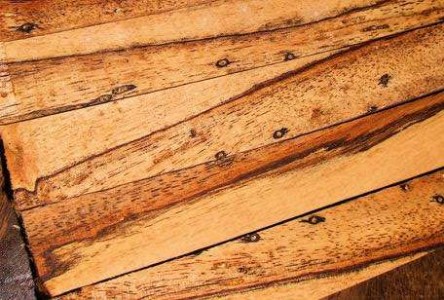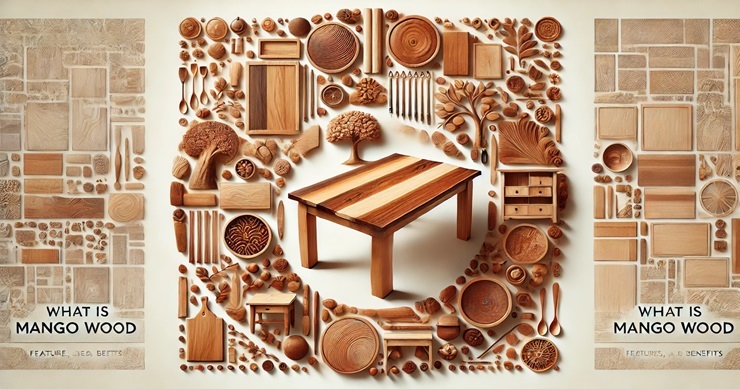Exploring the Unique Qualities and Versatile Applications of Mango Wood
So what is mango wood? Mango wood is the wood derived from the Mango tree (scientific name Mangifera Indica for its origin in India), found in tropical countries of Southeast Asia, Australia and the South Pacific Islands. The mango tree is planted in great numbers for the trade of its fruits. However, these trees reach their maturity in 15-20 years and their fruit bearing capacity reduces greatly. After that planters often cut the tree down and sell the wood. In the recent years, the wood has found many takers from furniture makers as well as consumers, both due to its pros as hardwood furniture material and its sustainability quotient.
Features of Mango Wood
- Hardness: Mango wood is considered to be a hardwood. This strong and dense wood is at a rank of 1070 on the Janka hardness scale, comparable to black cherry wood or ash wood, and is perfect for furniture making as its durability is not affected by regular use. Though hardwood is difficult to cut and shape, mango wood is one of the softest hardwoods around making it suitable for use a construction material or for furniture making.
- Grain and Texture: In its natural form, mango wood grain is either straight or curly and interlocked. However, its look can be enhanced by polishing it.
- Color: The core of the mango tree or its heartwood is generally golden brown. However, at times, it may also be pink, with or without black streaks or golden brown.

Why Go for Mango Wood
- Mango wood is sustainable: A lot of consumers today are more aware of the impact of development, tree cutting and CO2 emissions on environment and prepared to do their bit by going green. This has also prompted manufacturers to look for green or sustainable options while selecting components/raw materials as well as the manufacturing process. This is where the rising popularity of mango wood as furniture wood comes from. Mango trees need to be cut down after they stop bearing fruit and by this time they reach a height of almost 20 metres and wield too much wood to be simply left to rot or burnt as fuel. The fact that mango tree is planted mainly for its fruit, grows and matures relatively faster, and its wood can be used as durable construction or furniture material makes mango tree wood one of most sustainable options among woods.
- It has high water resistance: Since mango wood is resistant to water to a great extent, it is perfect for creating patio, deck or any other kind of outdoor furniture. For increased durability, it only needs polishing.
- Great designs: Mango wood is soft and pliable, so it is easier to carve and shape, contrary to other hardwood types. It is also very good material to carve antique or designer furniture because it affords elaborate carving designs.
- Price Difference: Mango wood is readily available and is a sustainable wood. This makes it affordable, unlike more expensive wood types like teak and Sheesham.
Common Uses of Mango Wood
Mango wood is quite receptive to waxing and staining making it possible to accentuate the patterns of its grain. This advantage of the tree coupled with the tree’s credentials as a better alternative to lumber-only hard wood trees has led to the use of its wood for manufacturing a number of items:
- Outdoor furniture: Mango wood is highly water-resistant and as such it’s good for making garden furniture.
- Large furniture pieces: Though mango wood is strong, it is quite light weight and great for making large furniture pieces like beds, dining table sets, display units, wall cabinets, kitchen cabinets, etc.
- Doors and window frames: Mango wood may also be used for making doors and window frames. Doors made of mango wood show off its naturally occurring colours and patterns. Though mango wood is moderately durable, its durability can be increased through treatment and polishing.
- Kitchen accessories: The hard and dense mango wood is perfect for making kitchen accessories like chopping boards, serving trays, bowls, salad servers, etc.
- Musical instruments: Mango wood is a comparatively soft hardwood and so it can be easily given intricate shapes needed for musical instruments like drums, ukuleles, and guitars.
- Veneers and plywood sheets: Slivers of mango wood are also used as veneer for furniture items made of low quality wood to give them a hardwood look or to enhance their appearance.
- Flooring: Mango wood is also sometimes used for flooring purposes though it is not a very long-lasting flooring material.
- Curing leather: It is an important source of tannins for curing leather.
Fungus Issues in Mango Wood
Mango wood is prone to both insect and fungus attack and which is why the wood is kiln-dried and treated with chemicals before being used for furniture manufacturing. Treated mango wood becomes an excellent alternative to more expensive hardwoods like teak and oak given its unique grain and texture, vivid coloring, lower price, and easy availability.
Taking care of mango wood furniture
Mango wood does not require too much of maintenance. However, in a dry weather it may develop cracks over a period if not kept hydrated. Also, if it is exposed to too much sun or other heat sources like the kitchen stove, it is better to moisturize it once a month or as and when it seems dry. All you need to take care of your mango wood items is wiping or polishing it lightly with a piece of cotton cloth and some fruit oil like lemon oil or orange oil. Avoid using alcohol based products as they may end up making the wood even drier.
Conclusion
All in all, mango wood which is basically a by-product of agro industry is an environment friendly and sustainable option for your furniture. Its kaleidoscopic colors make it attractive and stylish while its steady supply makes it a hardwood option that fits into everyone’s budget. No wonder then that more and more people are opting for furniture and accessories made of mango wood as an alternative to the other more expensive and less sustainable hardwood options. Though lightweight, mango wood is strong, hard, and dense.






